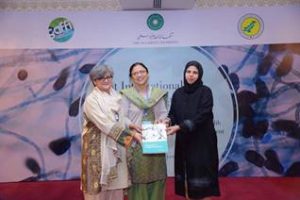Skin specialists around Pakistan have highlighted the fact that common fungal infections affecting the skin are now the leading cause of patients visiting skin hospital and clinics. Despite the prevalence of such infections and the reality of 3.2 million Pakistanis living with serious infections including keratitis, which can cause blindness, and the life-threateningCandida auris infection, researchers noted that there is no specific national policy on fungal disease.

Dr Joveria Farooqi, Prof Afia Zufar and Dr Kausar Jabeen (GAFFI ambassador for Pakistan)
“Fungal disease is an area almost forgotten by public health professionals and policymakers. Since treatment options for these diseases are already limited this policy oversight has dangerous implications. Fungal infections also represent a growing threat to the livelihood of our animals and plants which harms the country’s food security and biodiversity,” said Dr Kauser Jabeen, Associate Professor in the Department of Pathology and Laboratory Medicine at AKU and chair of the conference.
In a bid to combat this neglect, faculty members at the Aga Khan University have launched a comprehensive medical atlas. The new book Practical Guide and Atlas of the Diagnosis of Fungal Infections was launched at the 1st International Collaborative Mycology (ICM) Conference on Monday which was jointly organised by the global research and advocacy body, Global Action Fund for Fungal Infections (GAFFI), the Medical Microbiology and Infectious Diseases Society of Pakistan and AKU.
Speaking in a global context, Professor David Denning, president of GAFFI, stated that fungal infections claim 1.6 million lives around the world every year: a death toll that exceeds malaria and is equivalent to the lives lost to tuberculosis. Similarly, fungi and fungi-like micro-organisms, oomycetes (commonly known as water mould), destroy a third of all food crops around the world which would have fed 600 million people.
“The World Health Organization has no funded programmes specifically targeting fungal diseases, fewer than 10 countries have national surveillance programs for fungal infections, and fewer than 20 have fungal reference diagnostic laboratories. Many of the diagnostic tests that do exist are not available in developing countries, and well-established antifungal drugs that would cure disease are not reaching people that need them,” Professor Denning added.
Speakers at the book launch ceremony on the first day of the spoke about the high resolution microscopic images of over 20 types of fungal infections due to more than 60 fungal species that have been reported at the country’s healthcare institutions. Compiled over a period of 6 years and through a series of eight intensive workshops, the publication also contains detailed instructions to guide medical professionals and students in diagnosing these infections, they added.
Sessions at the conference also focused on the key concern of growing fungal resistance to medications which were narrowing treatment options and leaving patients little choice beyond very expensive drugs. Commenting on the challenges in treating by a serious fungal infection, Candida auris, which can trigger sepsis (a deadly illness that causes inflammation throughout the body), speakers noted that poor availability of medicines was leading to delays in treatment. Even when medicines were present, the prohibitive cost of using the second line drug, which can cost around Rs 13,000 per day, limited the availability of treatment, experts added.
Experts from various disciplines of medicine, veterinary medicine, agriculture, food and pharmaceutical industry were present at the two-day event. The conference was followed by a day of workshops at AKU’s Centre for Innovation in Medical Education.
The conference’s objectives to improve the diagnosis and treatment of fungal infections are in line with global efforts to achieve infectious disease targets under goal 3 of the Sustainable Development Goals: ensure healthy lives and promote well-being for all at all ages.
GAFFI issued a 10-year Roadmap in 2015 calling for ‘95-95 by 2025’, summarized as 95 per cent of patients with serious fungal infections are diagnosed and treated. https://gaffi.org/roadmap/